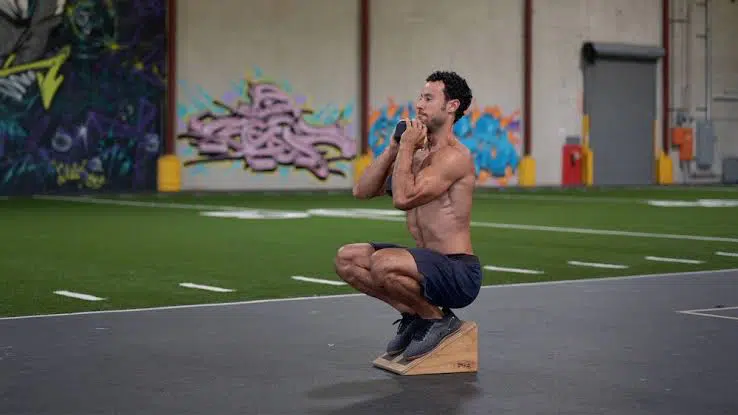You might be wondering what are some obvious Benefits of Elevated Goblet Squat, don’t worry in this article we should outline and explain 8 of them that we are sure of.
The elevated goblet squat can be performed as part of your regular workout routine to engage more muscles in your lower body and get more out of your routine.
This goblet squat variation focuses on your quadriceps, hamstrings, glutes, and core. It is great way to add variety to your workouts and it’s an effective exercise you can do anywhere, anytime with just one dumbbell and no equipment at all.

Here are 8 benefits of elevated goblet squat that you will see when you begin performing this move regularly.
PEOPLE ALSO READ; The Chest Exercises and Workouts You Need to Build Bigger Pecs
1. Glutes are Engaged
The elevated goblet squat really activates your glutes. You need to squeeze your glutes in order to push up from a squatting position, but you will find that it is much easier to activate them when you raise your hands on a weight.
In fact, if you do not have issues with lower back pain or injuries, hold a kettlebell or dumbbell in front of you during squats to get extra activation.
The muscles around your spine help stabilize as well and make sure that your spine stays aligned during squats.
Your core has to work harder too when holding weights overhead, increasing activation as well.
Even if they are small weights, they still feel heavy after holding them for long periods of time which can also make your workout longer and harder overall!
2. Improves Hamstring Flexibility
One of my favorite techniques to improve hamstring flexibility is to perform an elevated goblet squat.
It’s simple, all you have to do is stand tall, holding a weight or water bottle in your goblet hold and then squat down until your thighs are parallel with the ground.
As you rise up from that position, be sure to maintain a tall spine as you squeeze your glutes and abs at the top of each rep. Perform 3 sets of 10 reps, 2-3 times per week.
3. Athletes with Ankle Issues can Still do this Exercise
Because of its nature, and because you’re standing on your own two feet, elevated goblet squats aren’t as risky for an athlete who might have issues with their ankles.
But that doesn’t mean they won’t still put a lot of pressure on your legs and core.
If you’ve got any doubts about whether or not to do them, just remember, if you don’t try something new, then it will be impossible to know if it works for you.
So give these bad boys a shot—you might be surprised at how much you like them! Elevated goblet squats are awesome because they hit multiple muscle groups.
Your quads get worked during traditional barbell squats, but your hamstrings and glutes also take a beating when you’re squatting down.
With elevated goblet squats, though, those muscles get targeted even more intensely.
4. Posterior Chain Activation
Traditional squats—also known as back squats—work nearly every muscle in your legs and can improve your performance in other lower-body exercises.
But if you have knee or lower-back issues, they may not be right for you.
The goblet squat offers a way to isolate your quadriceps while getting a similar training effect on your posterior chain (your glutes and hamstrings).
These muscles play an important role in supporting healthy joints, so giving them extra attention is crucial for long-term strength development.
5. A Total body Movement
The goblet squat is a total body movement, as it heavily involves your legs and hips.
It’s also a compound exercise that works for multiple muscle groups at once, while also improving core strength, balance, and overall mobility.
One great benefit of doing goblet squats over traditional squats is that they require less stability from you while performing them.
If you have ever tried to do regular squats with weight and felt unstable, try using a lighter weight and elevating your feet to help improve your overall balance.
6. Fire Up your glutes
In a recent study, participants performed 4 sets of 8 elevated goblet squats three times per week for 3 weeks.
They found that their quadriceps muscles (the muscles on top of your thighs) grew by 22 percent and their gluteus maximus muscle (the muscle in your buttocks) increased by 11 percent which I think is really a great result.
7. Both Legs are Active at the Same time, Important in Athletic Development
Because you’re elevating your feet, there’s no weight on your back leg during an elevated goblet squat.
That means that both legs are working at all times, making for more functional strength and athletic development.
This helps to create more even-strength gains and muscle distribution throughout your body. You’ll be able to lift heavier weights.
The most effective way to build strength is by lifting heavyweight, but heavyweight can cause injury if done without proper form.
By lifting light weights and using proper form in elevated goblet squats, you can get all of the benefits while cutting down on the risk of injury or strain.
8. Simple Way to Engage your Posterior Chain and Fire up Your Glutes!
If you’re looking for a glute-strengthening exercise that doesn’t require a barbell, weight plate or squat rack, try an elevated goblet squat.
It’s much easier to do than it is to say! In addition to building strength in your quads and core, you’ll also be hitting your glutes from different angles.
A study from 2020 found that elevated goblet squats were just as effective at increasing muscle activation in deep (transversus abdominis) and superficial (rectus abdominis) abdominal muscle as deeper squats—but they had less spinal loading.
Because transversus abdominis has been shown to play a role in lumbar stability, adding TAsquats into your weekly routine can help protect against back injuries as well.
